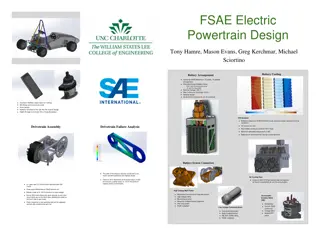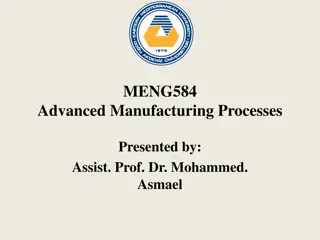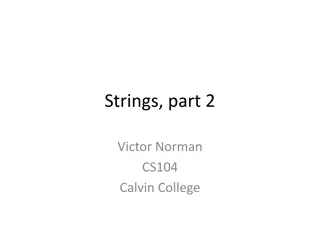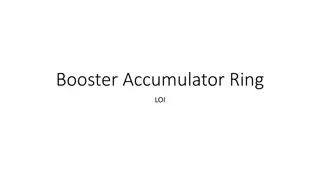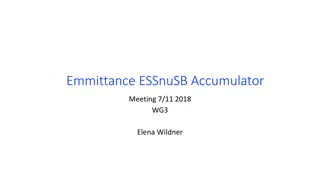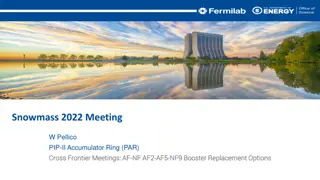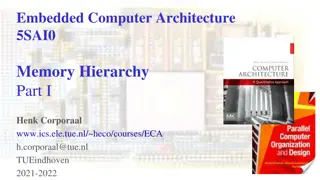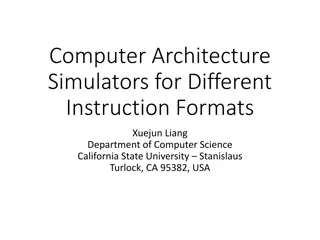Challenges and Design of High-Intensity Accumulator for Neutrino Experiments
The presentation discusses the challenges faced in designing an accumulator for high-intensity particle beams in neutrino experiments at ESS Lund, with a focus on beam loss management, injection efficiency, and intense beam physics issues. The design considerations include beam holding capacity, beam loss management, beam injection, and addressing unprecedented high-intensity beam physics issues. Also, the importance of efficient injection, beam loss management, and collimation are highlighted to ensure the success of the particle accelerator system.
Download Presentation

Please find below an Image/Link to download the presentation.
The content on the website is provided AS IS for your information and personal use only. It may not be sold, licensed, or shared on other websites without obtaining consent from the author.If you encounter any issues during the download, it is possible that the publisher has removed the file from their server.
You are allowed to download the files provided on this website for personal or commercial use, subject to the condition that they are used lawfully. All files are the property of their respective owners.
The content on the website is provided AS IS for your information and personal use only. It may not be sold, licensed, or shared on other websites without obtaining consent from the author.
E N D
Presentation Transcript
NUFACT 2017, Uppsala Status of the ESSnuSB Accumulator Elena Wildner, CERN 28/9/17 Accumulator, NUFACT17 Uppsala, E.Wildner
Artists view of the European Spallation Source, ESS Lund, Sweden 28/9/17 Accumulator, NUFACT17 Uppsala, E.Wildner
ESS Linac upgrade, neutrons and neutrinos n Upgrade (n+ ) Upgrade (n+ ) (n) 10 MW 2 GeV 62.5 mA >2.86/4 ms 28 Hz 45 MV/m 352.5 m 10 MW 2.5 GeV 50 mA > 2.86/4 ms 28 Hz 45 MV/m 352.5 + ca 70 m ms P+ and H- P+ and H- P + Linac ready by 2023: full power and energy (5 MW, 2 GeV) 2.7 1023 p.o.t. per year 28/9/17 Accumulator, NUFACT17 Uppsala, E.Wildner
The present neutrino target/horn design PSU Design for 4 Horns/EUROnu, WP2 P. Poussot 4 targets/horns (like the EUROnu design) 4 Power Supplies To get a good merit factor : Beam (H-)~ 1.5 s The duration of the ESS Linac Beam (2.86 ms) must, with the present target system design, be reduced to a few s to limit the ohmic heating of the focusing horn. This is the mission of the accumulator. 28/9/17 Accumulator, NUFACT17 Uppsala, E.Wildner
Challenges for an accumulator The 5 MW beam is a huge challenge: what does an accumulator look like to hold 1015 particles ? Beam loss management/collimation essential: With 1 Watt beam loss allowed on the tunnel walls per meter 5 MW, fractional loss of 0.2 10-6. Accumulator, several hundred meters 0.2 10 -4 Efficient injection H- injection H- source to be added Beam loss from injection system (not fully stripped H- ions and electrons) Beam loss from Lorentz stripping New transfer lines from the Linac to the accumulator Lorentz stripping in the injection transfer line (site layout to be adapted) Very high intensity beam physics issues in the accumulator (Tune shifts, resonances, instabilities, impedances ) Unprecedentedly High Intensity 28/9/17 Accumulator, NUFACT17 Uppsala, E.Wildner
High intensity and accumulator design Laslett formula for tune shifts r0N DQ=- x,y 2pEx,yb2g3Bf Our handles are 1. Intensity (N): Divide the intensity by 4 (use four rings or four batches) 2. Emittances (Ex,y): Injection process, target requirements 3. Relativistic properties of beam: Energy (given by physics needs, the ESS linac and site layout) 4. The Bunching factor Bf : Ignored for the time being (coasting beam), by assuming linac longitudinal structure smeared (to be verified) 28/9/17 Accumulator, NUFACT17 Uppsala, E.Wildner
1. Accumulator Design: Intensity The accumulator circumference should correspond to the requirements of the target/horn power supply design, < 1.5 s. 1.1 1015 circulating p and a circumference corresponding to about 1.5 s would result in tune shifts of 0.75 (target value < 0.2) Remedy: stack 4 accumulators (Baussan et al.:Nuclear Physics B Volume 885, August 2014, Pages 127-149), tune shifts would be reduced to acceptable values however expensive and operationally demanding. OR Pulsing of linac 4 times more often to fill accumulator sequentially Demanding on linac equipment: cavities, couplers etc. Demanding on target/horn powering Gives higher temperatures on injection foil Assessment of feasibility needed 28/9/17 Accumulator, NUFACT17 Uppsala, E.Wildner
2. Accumulator Design: Emittances Multiturn H- stripping injection or, later, laser stripping (research going on at SNS) Emittances and particle distributions can to some extent be created at injection Halo formation and blow up are estimated by simulations We have used the SNS lattice as a basis and adapted it to the ESSnuSB conditions and is now used for painting simulations with space charge. 28/9/17 Accumulator, NUFACT17 Uppsala, E.Wildner
3. Accumulator Design: Energy The Lorentz stripping gives a practical limit of the energy/bending of the transfer line 2.5 GeV gives a good extraction point from the linac Physics at 2.5 GeV is the choice with far detector at Garpenberg Keep in mind: Beam Dynamics tends to be easier to deal with at higher energy, we do simulations at 2.0 GeV 2.5 GeV Accumulator, NUFACT17 Uppsala, E.Wildner 28/9/17
H- Transfer Line: stripping rates 1 MW 1E-7 frac. loss to get < 0.1 W/m 5 MW < 1/5 E-7 frac. loss -> ~ 0.15 T 0.15 T and 2.5 GeV: Brho 11.02 Tm, rho=73.5 m in dipoles 66% dipole filling factor, transfer line tunnel rho=111 m. 28/9/17 Accumulator, NUFACT17 Uppsala, E.Wildner
Design of the ESS 2.5 GeV H- switch (from EURISOL) Key parameters are diameter of next downstream element, and beam size Need to switch in one long drift after the LINAC. Assume 0.3 m gaps between/at ends of switch dipoles Assume 100 mm radius (distance of beam axis from nearest physical element) is sufficient clearance for beam envelope, vacuum chamber and tolerances can then simply calculate the longitudinal space needed to achieve a given horizontal offset, together with the longitudinal position of the bending centre of the switch, and its horizontal deflection angle Courtesy Brennan Goddard, CERN 28/9/17 Accumulator, NUFACT17 Uppsala, E.Wildner
ESSnuSB baseline layout on the ESS site 2.5 GeV 28/9/17 Accumulator, NUFACT17 Uppsala, E.Wildner
Challenges for the ESS Linac 10 MW is a big step from 5 MW: Integrated Beam loss to be revised Linac equipment to be adapted In addition, ideas to design a good accumulator: Linac pulsing H- source to be integrated (most likely H- injection is needed) H- operation: optics and steering different for H- and p: requires pulse modulation of power-supplies Assessment of impact, including increase linac frequency has been performed 28/9/17 Accumulator, NUFACT17 Uppsala, E.Wildner
Assessment of required modifications of the ESS linac 28/9/17 Accumulator, NUFACT17 Uppsala, E.Wildner
Pulsing of the Linac To mitigate difficulties with high intensity! All simulations made with of total intensity (CERN) ( Assessment suggests < 56 Hz) 28/9/17 Accumulator, NUFACT17 Uppsala, E.Wildner
Injection with J-Parc like lattice @ 2 GeV S. Machida November 2016 Simulations (multi turn injection with anti correlated painting bumps) using a JPARC like lattice show no worrying space charge at 2 GeV SNS like magnets are fine Simplest possible lattice can do it! https://indico.esss.lu.se/event/618/session/3/contribution/1 28/9/17 Accumulator, NUFACT17 Uppsala, E.Wildner
Magnets https://indico.esss.lu.se/event/618/session/3/contribution/1 S. Machida 28/9/17 Accumulator, NUFACT17 Uppsala, E.Wildner
Liouvillian injection of p+ Courtesy Chris Prior To inject protons would be a significant simplification of the injection equipment Small beam loss No H- source or H- acceleration in the Linac No existing operational application exists However, The Chinese High Intensity Heavy Ion Accelerator Facility, HIAF, to be built in Huizhou, will use the tilted septum injection scheme. Applied to a J Parc like ring with ESS parameters would, for 550 turns, give no beam loss according to simulations (without space charge)!! 100 mm mrad emittance may be too constraining? 28/9/17 https://indico.esss.lu.se/event/618/session/3/contribution/3
ESS Accumulator simulations: filled ring Lattice based on SNS lattice to use the injection design Tests after injection (no painting, filled ring) 1 geo/norm emittance of 8.5/100@85% mm mrad (Gaussian) as required by the target E. Wildner, H. Sch nauer, J. Jonnerby Circumference 376 m Revolution time 1.32 s Natural Chromaticity -16 Linac Dp/p 0.2 %rms 15 % gap for extraction 550 turns (with full intensity): worst case Tune spread with tracking 0.2 (consistent with the Laslett formula calculation). Simulation Tool PyORBIT (including PTC external libraries) Grid 15x15 m Qx=10.395, Qy=11.321 Qy=11.202 Qx=10.395, Qy=11.321 Qy=11.202 Qy=11.254 Qy=11.254 Maja Olveg rd https://indico.esss.lu.se/event/618/session/3/contribution/0 28/9/17
ESS Accumulator simulations: painting Tests with painting correlated painting With SC, emittances slightly above the requirements Point b best choice Beam shapes seem to indicate some halo formation (non rectangular result of correlated painting) (Qx=10.395, Qy=11.254) Maja Olveg rd https://indico.esss.lu.se/event/618/session/3/contribution/0 28/9/17
Phase space plot indicates (Qx=10.395, Qy=11.254) Maja Olveg rd Lattice needs to be 4-fold (not 1-fold) In the lattice the injection section is special High beta values: lower temperatures on foil Injection Extraction Collimation RF 28/9/17 Accumulator, NUFACT17 Uppsala, E.Wildner
New Lattice development Horst Sch nauer SNS injection SS kept beta (x,y) @ injection point ~ (10, 20 ) m, equal in all 4 super periods Emittance from Linac: 0.33 mm mrad (nominally 0.25 mm mrad) Bunching factor 0.85 (coasting beam with extraction gap) Foil temperatures, important validity test: Without/with space-charge [Calc. Ref. : Liaw et. al, PAC N.Y. 1999, pp 3300] Target values 2040K (carbon melting temperature 3773K) Results with new lattice 56 Hz: Linac + recirculating beam 2060K, 3 rings 70 Hz: Linac + recirculating beam 1820K, 4 rings Results from earlier lattice versions give similar results. Next steps: Resonance analysis tuning of lattice Space charge analysis 28/9/17 Accumulator, NUFACT17 Uppsala, E.Wildner
Temperature on foil Horst Sch nauer Combined linac spot and circulating beam Temperature[K] 3 batches from Linac 4 batches from Linac Time [ms] Linac spot 28/9/17 Accumulator, NUFACT17 Uppsala, E.Wildner
Foil stripping will be possible Laser stripping is to prefer Promising tests at SNS From presentation at CERN by W. Bartman 9/17/13 WIN2013, Elena Wildner 24
Extraction of longer beams Fast extraction: 1 turn, 1.32 s Whole beam kicked into septum gap and extracted, beam for the neutrino target Non-resonant multi-turn extraction: few turns Beam kicked to septum; part of beam shaved off each turn, too lossy for ESS accumulator Resonant multi-turn extraction: many thousands of turns, continuous beam spill (lossy) Non-linear fields excite resonances which drive the beam slowly across the septum. Resonant low loss multi-turn extraction: few turns Non-linear fields used to trap bunchlets in stable island. Beam then kicked across septum and extracted in a few turns, could maybe be used N e u t r o n s, 100 s Lindroos/McGinnis, bunch by bunch, evaluate bunching techniques, 500 turns Bent Crystals, to be checked Would we dare even to dream of this??? Slow extraction , CA15139 Meeting, Sofis, Elena Wildner, CERN 10/15/16 25
Conclusions and future development Linac upgrades for ESSnuSB seem to be possible to implement [CERN-ACC-NOTE-2016-0050] Optics: the simplest possible lattice can do the job Simulations will indicate the number of accumulators/batches needed Temperature on foil seems ok, beam dynamics to check beam loss and beam properties Collimation to be designed, radiation studies an important issue Extraction for neutron requirements needs bunch by bunch extraction Magnet design is feasible: accelerators with similar conditions are running We are happy to get a post doc from Horizon 2020 ESSnuSB grants !!! 28/9/17 Accumulator, NUFACT17 Uppsala, E.Wildner
Parameter list for ESSnuSB Accumulator Update of Linac emittances@1 sigma in the DB: Transverse, 0.3519 pi.mm.mrad, and 0.3640 pi.mm.mrad. Longitudinal, in the phase-energy phase space it is 0.182 pi.deg.MeV. 28/9/17 Accumulator, NUFACT17 Uppsala, E.Wildner
Extra slides 28/9/17 Accumulator, NUFACT17 Uppsala, E.Wildner
Extraction Recommendation Lossy multiturn extraction is probably not feasible, an estimation of the should be made. This applies to Non- Resonant Multiturn extraction and Resonant Multiturn Extraction. Resonant low-loss multi-turn extraction, could in principle be possible, however the stability of the high intensity beam should be verified. The beam could be prepared for extraction at injection painting (particle distribution)? Bunch by bunch multi-turn extraction seems attractive, rf- requirements, impedance seen by beam (for beam stability during 100 microseconds) and kickers should be investigated The extraction system impedance should in all cases be evaluated. Slow extraction , CA15139 Meeting, Sofis, Elena Wildner, CERN 10/15/16 29
Emittances in Accumulator 28/9/17 Accumulator, NUFACT17 Uppsala, E.Wildner


